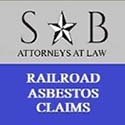
If you were employed by a railroad company before 1982, there is a high chance that you were exposed to asbestos during your time in the industry. Asbestos was commonly used in various products, ranging from brake shoes to ashtrays given to passengers on trains.
This means that even if you worked in the locomotive, you were at risk of inhaling and ingesting microscopic asbestos fibers. These fibers are so tiny that they cannot be seen in the air, and once they enter your body, they can become lodged permanently. This can lead to serious health issues, including genetic mutations and scarring.
The manufacturers of asbestos-containing products, including brake pads, were aware of the dangers associated with this toxic material, but they chose not to inform the public. Instead, they prioritized their profits over the well-being of hardworking Americans.
At Sammons & Berry, P.C., we are committed to helping retired railroad employees who have developed diseases such as asbestosis, cancer, and mesothelioma. Various types of cancer have been linked to asbestos exposure, including lung cancer, throat cancer, esophageal cancer, stomach cancer, and colon cancer.
If you are a retired railroad worker who has been diagnosed with any of these asbestos-related diseases, our team is here to assist you. We will work with you to determine if you qualify for compensation and ensure that you receive your fair share of the $30 billion dollars held in asbestos trust funds, which are specifically set aside to compensate those whose health has been impacted by asbestos.
Call us today to start the process of filing for an asbestos trust fund in order to get the compensation you deserve. Our team of experts are waiting for your call.
What Causes Asbestosis?
Exposure to high levels of asbestos fibers is what causes asbestosis to develop. The airborne fibers and dust can become trapped in the alveoli (tiny air sacs in the lung at the end of the airways), where they irritate and scar the lung tissue.
Since asbestosis is a progressive disease (meaning it gets worse over time), symptoms may not develop for up to 20 years after exposure. By this time the asbestos has significantly scarred the lung tissue, making it stiff and unable to expand normally. Smoking can increase the amount of damage done by asbestos and speed up the progression of the disease.
What Are the Symptoms of Asbestosis?
The effects of long-term exposure to asbestos typically don’t show up for 10 to 40 years after initial exposure. The most common symptoms are:
- Shortness of breath
- Persistent dry cough
- Chest tightness or chest pain
- Weight loss from loss of appetite
- A dry, crackling sound in the lungs while breathing in
- Wider and rounder than normal fingertips and toes (clubbing)
How Is Asbestosis Diagnosed?
Asbestosis is usually diagnosed by a careful medical history, exposure history and chest X-ray or CT scan that shows scarring of the lung tissues. This information, along with breathing tests, helps your doctor determine how severe your asbestosis is and how well your lung is functioning.
If you have a history of exposure to asbestos and you’re experiencing increasing shortness of breath, you should contact your primary care doctor about the possibility of asbestosis. He or she likely will refer you to a doctor specializing in lung problems (pulmonologist).
During the visit, your doctor will ask about your breathing, both at rest and during exercise. Your doctor will also ask about your job history in detail to determine how much you were exposed to asbestos. So, it would be a good idea to prepare the following information in advance:
- Your symptoms and the time they started
- Treatments given before for the symptoms and how they helped
- The work you have done over your entire career; the length of time you spent in each job; the nature of the work you performed.
- The products you were in contact with at work and whether or not you wore protective equipment
- Smoking history
- Any old medical records, including chest X-rays or CT scans
During the physical examination, your doctor will listen to your lungs to determine if the sounds are normal or not. Your doctor may then order the following tests:
- Chest X-ray
- CT scan
- Lung function test
Free Asbestos Exposure Consultation in United States
At Sammons & Berry, P.C. we offer a no-cost, no-obligation consultation, so you can discuss the facts of your case without paying for anything upfront. Asbestos trusts claims do not require a lawsuit, depositions, or courtrooms. The process is simple and easy for the client and should not require any stressful legal confrontations for the client. The law firm handles all of the claims for the client, helping you maximize your compensation.
We do not accept any payments from our clients until they receive compensation. We charge on a contingent fee basis, which means you pay a percentage of what you get paid in your claim. If we are unable to collect anything for you, there is no cost to you.
Call (800) 519-1440 to speak with a Sammons and Berry, P.C. representative and start your journey towards compensation.
Wrongful Death Claims For Families of Asbestos Victims
If you have lost someone in your family due to the harmful exposure of asbestos, you may be entitled to compensation. If you can provide the work history and a death certificate for your loved one, our attorneys can help you file an asbestos claim. We understand how difficult this process can be, this is why we work with you every step of the way to help you get the money you deserve. Reach out to our team today to learn more about filing a claim for a family member.
Sammons & Berry, P.C.
800-519-1440
View our Google Listing
View our Facebook


